
Franklinton is a neighborhood in Columbus, Ohio, just west of its downtown. Settled in 1797, Franklinton is the first American settlement in Franklin County, and was the county seat until 1824. As the city of Columbus grew, the city annexed and incorporated the existing settlement in 1859. Franklinton is bordered by the Scioto River on the north and east, Harmon Avenue on the east, Stimmel Road and Greenlawn Avenue on the south, and Interstate 70 on the west. Its main thoroughfare is West Broad Street, one of the city's two main roads.

Downtown Columbus is the central business district of Columbus, Ohio. Downtown is centered on the intersection of Broad and High Streets, and encompasses all of the area inside the Inner Belt. Downtown is home to most of the tallest buildings in Columbus.
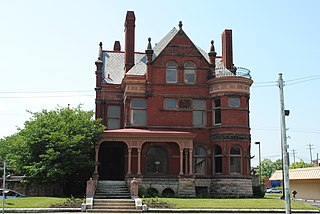
The W. H. Jones Mansion was built in 1889 at 731 East Broad Street, Columbus, Ohio as the residence of dry goods store owner William H. Jones and his wife Josephine. The original cost to build it was $11,250. He lived there until 1923. Jones modelled the house after another mansion in Barnesville, Ohio. The Olde Towne East Neighborhood Association successfully prevented it from being demolished to make way for a Long John Silver's restaurant. The home is an example of Queen Anne style architecture, with a corner turret, third story ballroom and a carriage house in the rear. Its foundation is high ashlar stone, its roof is slate, and the main body of the building is made of red pressed brick.

The Toledo and Ohio Central Railroad Station, today named Station 67, is a union meeting space and event hall located in Franklinton, near Downtown Columbus, Ohio. Built by the Toledo and Ohio Central Railroad from 1895 to 1896, it served as a passenger station until 1930. It served as an office and shelter for Volunteers of America from 1931 to 2003, and has been the headquarters of International Association of Fire Fighters Local 67, a firefighters' union, since 2007. The building was placed on the National Register of Historic Places in 1973. During its history, the building has experienced fires and floods, though its relatively few owners have each made repairs and renovations to preserve the building's integrity. The building is the last remaining train station in Columbus.

Engine House No. 6, also known as the East Franklinton Engine House, is a former Columbus Fire Department station in the East Franklinton neighborhood of Columbus, Ohio. The building was constructed in 1892, designed in the Romanesque Revival style by John Flynn. The station was decommissioned in 1966, and served as an electronics store from 1975 to 2014. It was listed on the National Register of Historic Places in 2016, accompanying planned renovations. The station has been planned to be sold since about 2016, originally to the Columbus Historical Society and Heritage Ohio, though the latter organization now plans to move to the Ohio History Center. The historical society acquired the building in November 2021, and is restoring it with plans to turn it into the city's first permanent local history museum.

The General William Henry Harrison Headquarters is a historic building in the East Franklinton neighborhood of Columbus, Ohio. It was listed on the National Register of Historic Places in 1972 and the Columbus Register of Historic Properties in 1985. The brick house was built in 1807 by Jacob Oberdier, one of Franklinton's first settlers. The house became especially important to the area from 1813 to 1814, when General William Henry Harrison, later the 9th President of the United States, used the house as his headquarters. It is the only remaining building in Ohio associated with Harrison.

The Krumm House is a historic building in the Brewery District neighborhood of Columbus, Ohio. It was listed on the National Register of Historic Places and Columbus Register of Historic Properties in 1982. The brick house was built c. 1885. The building was home to Alexander W. Krumm, the Columbus City Solicitor from 1878 to 1883. The property is also one of few remaining late 19th century houses on South High Street.
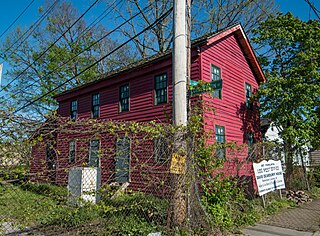
The Franklinton Post Office is a historic building in the Franklinton neighborhood of Columbus, Ohio. It was listed on the National Register of Historic Places in 1973. Also known as the David Deardurff House, it was built of hand-hewed logs by Deardurff in 1807. The two-story house sits on a limestone foundation. It is the oldest building in Columbus still on its original foundation. The building is on Gift Street, an area owned by Franklinton founder Lucas Sullivant, given to early settlers. The first post office in Franklinton was established here.
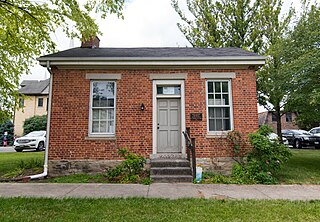
The Sullivant Land Office is a historic building in the East Franklinton neighborhood of Columbus, Ohio. It was listed on the National Register of Historic Places in 1973 and the Columbus Register of Historic Properties, along with the Gen. William Henry Harrison Headquarters, in 1985. The small brick building was built c. 1822. Its original use was as a single-room real estate office, although it was later expanded. At the time of construction, Lucas Sullivant was selling and giving away pieces of land, and Franklinton became the county seat of Franklin County. The building is the only remaining structure associated with Lucas Sullivant in the Franklinton area. In the early 1980s, the Columbus Recreation and Parks Department moved the building from its original location at 714 W. Gay St. to 13 N Gift St., behind the William Henry Harrison house. The move was prompted because the building was endangered in its original location, with vandalism, deterioration, and plans to create a parking lot for a car dealership on the site.

The Lubal Manufacturing & Distributing Company buildings are a set of two industrial buildings in the Franklinton neighborhood of Columbus, Ohio. The site was listed on the Columbus Register of Historic Properties in 2015 and the National Register of Historic Places in 2016. The buildings include 373 West Rich Street, built c. 1900, and 375 West Rich Street, built c. 1911. With much of the original materials intact, the buildings are few remaining that demonstrate Franklinton's early industrial and commercial history.
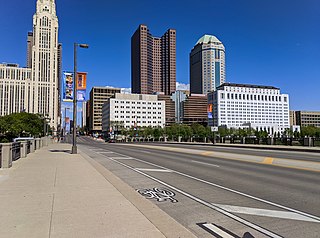
Broad Street is a major thoroughfare in Central Ohio, predominantly in Franklin County and Columbus. It stretches east from West Jefferson at Little Darby Creek to Pataskala. The street is considered one of Columbus's two main roads, along with High Street.

The Charles S. Barrett Building is a historic building in the Merion Village neighborhood of Columbus, Ohio. It was listed on the Columbus Register of Historic Properties in 2006 and the National Register of Historic Places in 2015. The building was completed in 1900 as the home of the city's South High School, part of the Columbus Public School District. It has since been converted into apartments, rented out as The Barrett.

The Felton School was a public school building in the Mount Vernon neighborhood of Columbus, Ohio, and a part of the Columbus Public School District. It was listed on the National Register of Historic Places in 1984 and the Columbus Register of Historic Properties in 1985.

The Third Avenue and North High Historic District is a historic district in the Short North neighborhood of Columbus, Ohio. It was listed on the National Register of Historic Places in 1990. The site consists of 24 buildings, including six that are non-contributing. Most are commercial or multifamily residential brick buildings built between 1900 and 1920.

The Franklinton Apartments at Broad and Hawkes are a set of historic buildings in the Franklinton neighborhood of Columbus, Ohio. The buildings were built in 1900 and listed on the National Register of Historic Places in 2005. The rowhouse buildings are on West Broad Street, in the commercial center of the neighborhood. The two buildings are in an L-shaped plan and contain 22 apartments. The buildings are significant as they represent the neighborhood's residential investment following an industrial boom. They are one set of four L-shaped corner rowhouses built in Franklinton in 1900, and another was built in 1910. It is a defined property type relatively unique to the neighborhood, with only one other known example elsewhere in the city.

The H.C. Godman Company was a shoe manufacturer based in Columbus, Ohio. The manufacturer was the first of significance in the city, founded by Henry Clay Godman as Hodder and Godman Leather in 1876. It operated until 1962, only one of two local shoe manufacturers in Columbus to survive into the 1960s.

The First Avenue School is a former public school building in the Harrison West neighborhood of Columbus, Ohio. It was listed on the Columbus Register of Historic Properties in 1983, and was listed as part of the Near Northside Historic District, on the National Register of Historic Places, in 1980. The building is one of the oldest in the neighborhood, built in 1874. It is also one of the oldest remaining school buildings in Columbus, built at the same time as the Second Avenue School and Stewart Alternative Elementary, also still extant. In 1984, Wood Development remodeled the building into the First Avenue Office Center at a cost of $1.2 million.
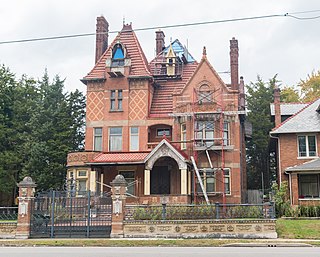
The Charles Frederick Myers house is a historic private residence in the Franklin Park neighborhood of Columbus, Ohio. The house was built in 1896 in an eclectic style. It was added to the Columbus Near East Side District in 1978, and the Bryden Road District in 1990.

The 1840 Franklin County Courthouse was the first permanent courthouse of Franklin County, Ohio in the United States. The building, located in the county seat of Columbus, stood from 1840 to 1884. The building was replaced with another county courthouse in 1887, and after its demise, that courthouse was replaced with Dorrian Commons Park, open from 1976 to 2018; the courthouse moved to a new building nearby. The site is now planned to host the Franklin County Municipal Court.

120 S. Central Avenue is a former school building in the Franklinton neighborhood of Columbus, Ohio. The building was built for the West High School, and later served as Starling Middle School and Starling Elementary School. The building was added to the National Register of Historic Places and Columbus Register of Historic Properties in 2022.





















